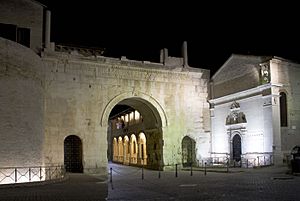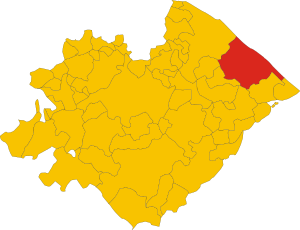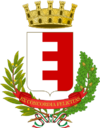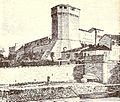Fano facts for kids
Quick facts for kids
Fano
|
||
|---|---|---|
| Comune di Fano | ||

Arch of Augustus
|
||
|
||

Fano within the Province of Pesaro-Urbino
|
||
| Country | Italy | |
| Region | Marche | |
| Province | Pesaro e Urbino (PU) | |
| Frazioni | Bellocchi, Caminate, Carignano, Carrara di Fano, Centinarola, Cuccurano, Falcineto, Fenile, Magliano, Marotta, Metaurilia, Ponte Sasso, Roncosambaccio, Rosciano, Sant'Andrea in Villis, Torrette di Fano, Tre Ponti | |
| Area | ||
| • Total | 121 km2 (47 sq mi) | |
| Elevation | 12 m (39 ft) | |
| Population
(31 December 2017)
|
||
| • Total | 60,978 | |
| • Density | 504.0/km2 (1,305/sq mi) | |
| Demonym(s) | Fanesi | |
| Time zone | UTC+1 (CET) | |
| • Summer (DST) | UTC+2 (CEST) | |
| Postal code |
61032
|
|
| Dialing code | 0721 | |
| Patron saint | Saint Paternian | |
| Saint day | 10 July | |
Fano is a historic town in the Marche region of Italy. It is located on the Adriatic Sea coast, about 12 kilometers (7.5 miles) southeast of Pesaro. Fano is a popular beach resort and the third largest city in its region by population.
Contents
History of Fano
Ancient Times
Fano was first known as Fanum Fortunae, named after a temple dedicated to the Roman goddess of luck, Fortuna. Its history goes back to 49 BC. At that time, the famous Roman leader Julius Caesar controlled Fano, along with other nearby towns.
Later, the Roman Emperor Caesar Augustus made Fano a colony. This meant it was an important Roman settlement. He also built strong walls around the city, and some parts of these walls can still be seen today. In 2 AD, Augustus built a large arch, which is still standing and is a famous landmark.
In 271 AD, the Roman Army fought and defeated the Alamanni in the Battle of Fano. This battle happened near the Metauro river, close to Fano.
Medieval Period
In 538 AD, Fano was destroyed by the Ostrogoths, a Germanic tribe. However, the Byzantines rebuilt it. Fano then became the main city of the maritime Pentapolis. This was a group of "Five Cities" that also included Rimini, Pesaro, Senigallia, and Ancona.
In 754 AD, the Frankish kings gave Fano to the Holy See, which is the government of the Catholic Church.
Malatesta Family Rule
The powerful Malatesta family took control of Fano in 1356. They ruled the city, even though they were officially representatives of the Popes. One famous ruler was Pandolfo III Malatesta. His son, Sigismondo Pandolfo Malatesta, was a well-known military leader.
Eventually, Fano was besieged by Papal troops and returned to the Pope's control. It was briefly part of the state ruled by Cesare Borgia, and then became part of the duchy of the della Rovere family in the Marche region.
Modern Era
During the Napoleonic Wars, Fano suffered a lot of damage. The city also played an active role in the Risorgimento, which was the movement to unify Italy.
In World War I, Fano was bombed several times by the Austro-Hungarian Navy. During World War II, Allied planes heavily bombed the city. They aimed for the important railway and street bridges over the Metauro river. When the Nazis left the town, they destroyed all the bell towers.
Fano also experienced earthquakes. In 1916, two spires of the Fano Cathedral fell. Parts of other church walls and bell towers also collapsed. A strong earthquake in August 1916 caused many people to leave the town.
Main Sights in Fano
Fano has many interesting historical buildings and places to visit.
Religious Buildings
- Fano Cathedral: This church was built in the 12th century. It stands on the site of an older cathedral that burned down in 1111. The front of the church was rebuilt in the 1920s, but it looks similar to the original.
- San Domenico
- San Pietro in Valle
- San Paterniano: Built in the 16th century, this church has a beautiful Renaissance cloister.
- San Francesco: This church holds the tombs of Pandolfo III Malatesta and his first wife. The tomb was designed by the famous artist Leon Battista Alberti.
- Santa Maria Nuova: This church, built in 1521, has an old entrance. It also features two important artworks by Pietro Perugino, including the Annunciation of Fano. Some believe Raphael might have helped with one of these paintings.
Outside the city, in a place called Bellocchi, you can find the church of St. Sebastian. It was built in the 16th century using parts from the ancient cathedral.
Secular Buildings
- Arco d'Augusto: This is a Roman gate. The top part was destroyed during a siege in 1463. However, a carving of it was made in 1513 on a nearby church wall.
- Corte Malatestiana: This palace was built after 1357 by Galeotto I Malatesta. It includes a large hall from the 14th century and a small tower. The newer part was built between 1413 and 1423. The palace was heavily restored in the 20th century. You can still see original Gothic-style windows, a staircase, and a loggia from a 16th-century restoration.
- Rocca Malatestiana (Malatesta Castle): This castle was partly destroyed in 1944. Its oldest parts might be from Roman or medieval times. The castle we see today was started in 1433 or 1438 by Sigismondo Pandolfo Malatesta. The main tower, which is now missing, was built in 1452.
- Museo Civico of Fano: This museum is located inside the Palazzo Malatestiano. It has an archeological museum and an art gallery. You can see paintings by famous artists like Guercino and Giovanni Santi.
- Palazzo del Podestà or della Ragione: This palace was built starting in 1229 in a Romanesque-Gothic style. Inside, it has a museum with old findings, coins, and an art gallery with works by artists like Guido Reni.
- Fontana della Fortuna (Fountain of Fortune): This fountain was built in the 17th century.
Culture
- Fano dei Cesari: This event happens every year in July or August. It lasts for a week and includes many cultural activities. It ends with a parade where people dress in Roman costumes and have chariot races.
- Fano Jazz by The Sea: This jazz festival is held annually for one week.
- Biblioteca Federiciana: This library was founded on November 17, 1720.
Sports
Ultimate Frisbee
The Ultimate Frisbee Fano Association was started in 2001. It has four teams:
- Croccali (mixed team)
- Mirine (women's team)
- Spaccamadoni (men's team)
- Angry Gulls (junior team)
Since 2001, the association has won 8 Italian championships!
Notable People
Many interesting people have come from Fano:
- Sebastiano Ceccarini (1703–83), a painter.
- Clement VIII, Ippolito Aldobrandini (1536–1605), who became a pope.
- Menahem Azariah da Fano (1548–1620), a famous Rabbi and Kabbalist.
- Antonio Giuglini (1825–65), an opera singer.
- Fathi Hassan (born 1957), an artist.
- Carlo Magini (1720–1806), a painter.
- Roberto Malatesta (c. 1441-1442–1482), a military leader and lord of Rimini.
- Laura Martinozzi (1639–87), a duchess.
- Bruno Radicioni (1933–97), a painter, sculptor, and ceramist.
- Ruggero Ruggeri (1871–1953), an actor.
- Giacomo Torelli (1608–78), a set designer.
- Franco Trappoli, Mayor of Fano (1980–83) and the first Buddhist member of the Italian Parliament.
International Relations
Fano is twinned with several cities around the world. This means they have special friendly relationships and often share culture and ideas.
 Rastatt, Germany
Rastatt, Germany Saint-Ouen-l'Aumône, France
Saint-Ouen-l'Aumône, France St. Albans, United Kingdom
St. Albans, United Kingdom Stribro, Czech Republic
Stribro, Czech Republic Binbrook, Ontario, Canada
Binbrook, Ontario, Canada Sault Ste Marie, Canada
Sault Ste Marie, Canada
Images for kids
See also
 In Spanish: Fano para niños
In Spanish: Fano para niños




